deltaH
Dangerous source of unreferenced speculation
    
Posts: 1663
Registered: 30-9-2013
Location: South Africa
Member Is Offline
Mood: Heavily protonated
|
|
Failed OTC preparation of ammonium carbamate from urea
This experiment failed and the content of this thread is highly speculative. Reader discretion is advised -
Vulture
EDIT:
Introduction:
I wanted to find an 'easy' way to convert urea into a solid source of ammonia for organic syntheses. I had the idea that ammonium carbamate would be
an excellent candidate for this as it is easily hydrolyzed to ammonia, partially soluble in some organic solvents and also a source of NH4+ that can
serve as acid in mechanisms that require it, for example in Mannich condensations where a mix of NH3 and NH4+ is required.
The question is how to make this from urea (as a cheap OTC source) which is not so easy to hydrolyse as carbamate?
v2.0: Still under development
This is the much better route, no ammonia stink in the beginning and complete urea hydrolysis by using excess acid
WARNING:
Large volumes of gas and heat will be generated from step one if the acid is added in one go and all heated. The whole lot of urea should be brought
to a boil and acid added incrementally while boiling for a while to do the hydrolysis gradually! Second step should be conducted in a fume cupboard
because of ammonia stench!
While boiling:
1) (NH2)2CO(aq) + 1.5H2SO4(aq) + H2O(l) => (NH4)2SO4(aq) + 0.5H2SO4(aq) + CO2(g) + heat
(Note: 0.5 H2SO4 excess to ensure complete hydrolysis)
Then starting from room temperature:
2) (NH4)2SO4(aq) + 0.5H2SO4(aq) + (i)NaOH(aq) + (ii)Na2CO3(aq) => 1.5Na2SO4(s) + NH4O2CNH2(aq) + H2O(l) + heat
...after slow and not excessive alcohol addition to precipitate Na2SO4(s) under stirring (ammonium carbamate remains in solution).
The order of adding NaOH and Na2CO3 is important in step two. One must add the NaOH first to neutralise the solution, then only the Na2CO3, or you
will simply evolve lots of CO2 gas and end up with the wrong NH3/CO2 ratio!
This avoids smelly ammonia formation until the last step and that can be minimised by working with not too hot solutions and in a fume cupboard!
Finally filter hot to remove Na2SO4 and then cool to crystallize carbamate.
Acknowledgement:
Thanks bbartlog for points raised and inspiration that lead to new set of equations that get's around problem of incomplete urea
hydrolysis from v1.0
Appendix A:
v1.0 my first crap route because of incomplete urea hydrolysis - DO NOT USE- here for historical reasons 
1) (NH2)CO(aq) + NaOH(aq) => NaO2CNH2(aq) + NH3(aq) + heat
2) (NH2)CO(aq) + 2HCl(aq) + H2O(l) => 2NH4Cl(aq) + CO2(g) + heat
3) NaO2CNH2(aq) + NH3(aq) + 2NH4Cl(aq) => NaCl(s) + NH4O2CNH2(aq) + NH3(aq) (using selective precipitation by alcohol addition)
[Edited on 30-10-2013 by deltaH]
[Edited on 4-11-2013 by vulture]
|
|
|
testimento
Hazard to Others
  
Posts: 351
Registered: 10-6-2013
Member Is Offline
Mood: No Mood
|
|
Thanks for the details. I'm processing another process which involves hydrolysis of urea with calcium hydroxide.
Can you determine, how toxic isocyanic acid is, when it is released by pyrolysis of calcium carbamate?
|
|
|
deltaH
Dangerous source of unreferenced speculation
    
Posts: 1663
Registered: 30-9-2013
Location: South Africa
Member Is Offline
Mood: Heavily protonated
|
|
Quote: Originally posted by testimento  | Thanks for the details. I'm processing another process which involves hydrolysis of urea with calcium hydroxide.
Can you determine, how toxic isocyanic acid is, when it is released by pyrolysis of calcium carbamate? |
Have
a read through through my thread on cyanurate fire fighting plaster If you add calcium carbonate, then you could possibly use the same principle to 'neutralise' your isocyanic acid
as it forms and so release much less and still end up with the same products (if you're after calcium cyanamide)... in fact you should make much more
cyanamide that way.
There is also a paper there that gives invaluable info on calcium cyanurate chemistry in general (has done it's rounds on this forum). Also be careful
with calcium case as I am not so sure you could readily prepare calcium carbamates.
In solution carbamates are in equilibrium with all kinds of ions, including carbonates and bicarbonates to name but a few, carbamate chemistry is
seldom 'clean'. For example, commercially available ammonium carbonate is not ammonium carbonate, but a mixture of ammonium carbamate and carbonate.
So what I am trying to say is that when you have calcium around, calcium LOVES carbonate ions and will always sink these to form highly insoluble
CaCO3.
Under more acidic conditions, you would probably form calcium cyanurates or mixtures with carbonates by ammonia elimination of urea... hence why I
pointed you to that thread.
I'm not saying this will happen, I'm just saying bear in mind the added complexity and issues that can happen.
As for the toxicity, I am under the impression that it is much less toxic than cyanide, but still not something you would want to breath in (says
poisonous on wiki)! I in fact developed that carbonate neutralising trick to get rid of it from a calcination (in theory) and ended up making a
potentially great CO2 releasing formula!
[Edited on 29-10-2013 by deltaH]
|
|
|
kmno4
International Hazard
    
Posts: 1497
Registered: 1-6-2005
Location: Silly, stupid country
Member Is Offline
Mood: No Mood
|
|
| Quote: | | OTC preparation of ammonium carbamate from urea |
(...)
This is not chemistry, not even speculations.
Just plain brainfart.
Слава Україні !
Героям слава !
|
|
|
deltaH
Dangerous source of unreferenced speculation
    
Posts: 1663
Registered: 30-9-2013
Location: South Africa
Member Is Offline
Mood: Heavily protonated
|
|
Quote: Originally posted by kmno4  | | Quote: | | OTC preparation of ammonium carbamate from urea |
(...)
This is not chemistry, not even speculations.
Just plain brainfart.
|
I'm sorry, I don't speak troll
|
|
|
bbartlog
International Hazard
    
Posts: 1139
Registered: 27-8-2009
Location: Unmoored in time
Member Is Offline
Mood: No Mood
|
|
The problem is that base-catalyzed hydrolysis of urea does not proceed as you describe. Maybe that is what kmno4 is hinting at. The net reaction as I
understand it is NaOH + CO(NH)<sub>2</sub> + H<sub>2</sub>O -> Na<sub>2</sub>CO<sub>3</sub> +
2NH<sub>3</sub>
Sodium carbamate may be an intermediate in the reaction and maybe it could even be the primary product under the right circumstances, but even if that
is the case you would still need some sort of workup after step 1) to separate it from the sodium carbonate and unreacted urea.
Anyway, the urea itself is a fine solid source of ammonia. Just add hot aqueous base. If that's the main goal there doesn't seem to be any compelling
reason to try to transform it into sodium carbamate.
The less you bet, the more you lose when you win.
|
|
|
deltaH
Dangerous source of unreferenced speculation
    
Posts: 1663
Registered: 30-9-2013
Location: South Africa
Member Is Offline
Mood: Heavily protonated
|
|
Quote: Originally posted by bbartlog  | The problem is that base-catalyzed hydrolysis of urea does not proceed as you describe. Maybe that is what kmno4 is hinting at. The net reaction as I
understand it is NaOH + CO(NH)<sub>2</sub> + H<sub>2</sub>O -> Na<sub>2</sub>CO<sub>3</sub> +
2NH<sub>3</sub>
Sodium carbamate may be an intermediate in the reaction and maybe it could even be the primary product under the right circumstances, but even if that
is the case you would still need some sort of workup after step 1) to separate it from the sodium carbonate and unreacted urea.
Anyway, the urea itself is a fine solid source of ammonia. Just add hot aqueous base. If that's the main goal there doesn't seem to be any compelling
reason to try to transform it into sodium carbamate.
|
Hey bbartlog, nah he's just being a troll and makes no point either, but enough of that, as I said, I don't speak troll, you on the
other hand DO make points 
Firstly your equation needs balancing.
Next there's this resource that may help as a general resource on this system for all (though I could use something a little better to be honest).
It's important to realise that the ratio of dissolved CO2 species and NH3 species (forming all kinds of ions in equilibrium) determines the favoured
product and it's a fast ionic equilibrium, quickly readjusting in solution (not the urea hydrolysis though).
As for your third point (sorry I will tackle second one last), the nice thing about the ammonium carbamates is their solubility in organic solvents,
low water content and lots of NH4+/low basicity... making them potentially useful for the Mannich condensation I intend to use it in. But that is just
a hypothesis for now... I am going to try it out 
As for your second point about the unreacted urea, that's a good one, perhaps one needs to use 2 equivalents or more of NaOH to ensure it goes all the
way, then create the correct CO2 to NH3 ration with the addition of the HCl instead of NH4Cl.
The reactions are then, say:
(NH2)2CO(aq) + 3NaOH(aq) =>Na2CO3(aq) + 2NH3(aq) + NaOH(aq)
(Note NaOH excess)
Then
Na2CO3(aq) + 2NH3(aq) + NaOH(aq) + 3HCl => 3NaCl(s) + NH2O2CNH2(aq) + H2O(l)
after adding some alcohol.
But at boiling, one probably looses too much ammonia from step 1. So better to do it the other way around!
(NH2)2CO(aq) + 3HCl(aq) + H2O(l) => 2NH4Cl(aq) + HCl(aq) + CO2(g)
(Note HCl excess)
then:
2NH4Cl(aq) + HCl(aq) + Na2CO3(aq) + NaOH(aq) => 3NaCl(s) + NH4O2CNH2(aq) + H2O(l)
(after alcohol addition)
This way we avoid making smelly ammonia from step 1! I like it.
Thanks, good point!
Finally, I think its important to add the alcohol slowly and not too much, otherwise you risk precipitating on kinetic basis and not equilibrium (dump
all kinds of ions out as salts and might mess the CO2/NH3 ratio in solution).
I think I might switch to using sulfuric acid as I would imagine Na2SO4 is even more insoluble when you start adding alcohol than NaCl?
BTW... some of you might be thinking why not make ammonium carbamate from dry ice and ammonia, that DOES work very well, I just don't have dry ice or
ammonia but I have lots of urea and can buy washing soda and battery acid for bugger all down the road 
I've updated the primary post and acknowledged your contribution! THANKS!
[Edited on 29-10-2013 by deltaH]
|
|
|
Nicodem
|
Thread Moved
30-10-2013 at 10:06 |
woelen
|
Thread Pruned
30-10-2013 at 14:12 |
woelen
Super Administrator
        
Posts: 8014
Registered: 20-8-2005
Location: Netherlands
Member Is Offline
Mood: interested
|
|
I pruned the thread and will move the pruned part to detritus. Let's give this a second chance and hopefully the crap is not repeated.
A call to deltaH: Try to backup your ideas with experiments. It would help a lot if you indeed tried out things. Even if theory predicts certain
reactions to occur, in practice things may work out quite differently. Your proposed mechanisms should not be that hard to try and the required
chemicals are not hard to obtain.
|
|
|
deltaH
Dangerous source of unreferenced speculation
    
Posts: 1663
Registered: 30-9-2013
Location: South Africa
Member Is Offline
Mood: Heavily protonated
|
|
Step 1: Urea decarbonation/hydrolysis
WARNING:
(i) Reaction must be conducted outside as it gives off pungent toxic fumes.
(ii)Boiling acids are EXTREMELY corrosive burning flesh instantly if it gets on you. Wear all the necessary safety equipment, high rubber gloves,
plastic apron and face shield! Have water shower at the ready nearby.
(iii)A much larger container than the volume of the reaction mixture is necessary (5 times larger) as effervescence is very vigorous when it
commences and creates a rising froth. The large container alone is not enough to manage this, you have to remove it from the heat when it starts to
run away to ensure it doesn't froth over!
(iv) Have some bicarbonate of soda handy in case this happens and you need to neutralise spilled acid quickly.
***********************************************
Okay, I carried out the first step in my urea to ammonium carbamate process with OTC chemicals.
STEP 1 equation:
2H2SO4 + (NH2)CO + H2O => 2NH4HSO4 + CO2(g)
Note: I decided to use two mole equivalents of acid to target the formation of highly acidic ammonium bisulfate in order to [hopefully] ensure near
complete hydrolysis of the urea by having extremely acidic conditions even at the end of the reaction.
1l OTC Battery acid was weighed to calculate concentration using this table. Mine turned out to about 37%.
This was then poured into a large (+-5l) Vision cookware ceramic glass pot and heated over a strong gas flame.
113 g urea was then weighed and added to the heating acid solution and quickly dissolved.
ASIDE: I did this in spoonfull increments as I was trying this out for the first time and was concerned of possible run away, however, as my acid
was already very hot and when the urea hit the acid, a small amount of effervescence occurs that gives off a small amount of a choking pungent fume
(subsides in a second as the prills dissolve). I was worried that this could have formed small amounts of toxic isocyanic acid due to the momentarily
high urea concentration hitting the very hot acid. In hindsight, as nothing dramatic happens shortly afterwards, it would have been better to
dissolve all my urea in the dilute acid in the beginning and then heat from there to avoid this possible isocyanic acid formation as the prills
dissolve in a second after hitting the hot acid.
After the addition of the urea was completed, the mixture boils happily on a strong flame during which the volume reduces greatly. This is more than
likely simply water boiling off. Decarbonation of the urea only happens once the solutions starts to become fairly concentrated and very hot. It has a
distinctly different look about it, like dropping an alka seltzer tablet into water... it fizzes more than boils.
At some some point the boiling subsides (after about 30 minutes strong heating) and a slight effervescence starts to become apparent. At this point I
started to take photos. Several minutes passed between shots (well some of them anyway) as there is quiet a lag between the time boiling subsides and
strong effervescence kicks off. Strong heating was continued throughout and only stopped when the effervescence began to run away which happens only
momentarily, after which heating was continued again.
This slight effervescence stage continues for a while and at this point you need to keep a constant eye on it because very quickly,
this effervescence will start to accelerate at some point (see photo sequence). Shortly after the second to last effervescent photo was taken, the
froth started rising up my pot and threatened to spill over so I removed it from the flame and placed it on a wooden plank. The effervescence
continued for a while off heat (but manageably so), then it started to subsided at which point I returned it to the flame.
I kept monitoring it closes but within a few minutes, it started subsiding almost at once rather dramatically. I managed to snap a final photo just
before the froth disappeared and then finally disappeared completely leaving a clear, slightly discolored solution a minute or two later.
I continued heating for several minutes longer. A small amount of bubble could be seen rising, at this stage, but very little. It would appear that
the bulk of the reaction was over. Some swirling still resulting a some effervescence, but not much.
All in all, about an hour of strong heating was affected from the start.
I then set the pot aside on a wooden plank to cool to RT and snapped a photo of the beautiful crystal masses that formed.
I assume this is mostly ammonium bisulfate. The only byproduct I can think of that might have formed would be sulfamic acid, but I don't think there
can be much of it because of the water content in this reaction. Aside: sulfamic acid is generally prepared by reacting urea with oleum followed by
boiling in conc. sulfuric acid to affect decarbonation without hydrolysis. I want the hydrolysis hence why I employ the wet acid route.
Tomorrow I do STEP 2: a crude neutralisation with NaOH to yield a mixture of ammonium sulfate and sodium sulfate.
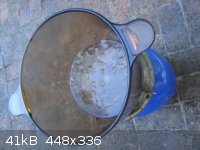 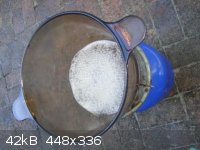 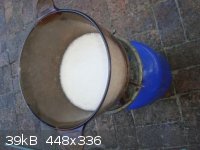 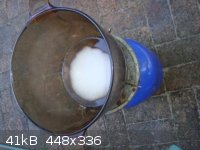 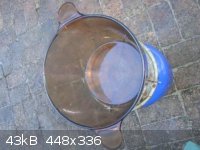 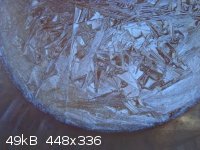
STEP 2: Neutralisation
I had some extra time tonight so could proceed with a neutralisation test. After all this is indicative of what happened in step one!
Sadly I don't have good news here. While the crystal mass I made was extremely water soluble (nearly the whole lot dissolved in just 200ml
water), which was encouraging in that this was expected for ammonium bisulfate, I nevertheless needed to add much much more base to neutralise it than
stoichiometric.
Eventually there was a strong smell of ammonia from the solution upon excess base, but I could tell that only a portion of the urea appeared to have
hydrolysed.
The crystal mass must therefore have been a mixture of ammonium bisulfate and urea bisulfate!
That's pretty useless.
What I don't understand is why the effervescence of the urea decomposition proceeded so nicely and then ended so sharply and promptly (seeming like
the limiting agent was consumed). Very odd behaviour for something that still needed quite a way to go?!
Trying to unravel what happened during STEP 1:
I believe the problem and limiting agent here is water!
Since effervescence only kicks off when the solution is very concentrated, it may be that it runs out of water. After all my product crystal mass
did not appear to contain much water and water is needed to decompose urea to ammonium bisulfate and CO2.
The next time I try this again, I think I'll add water dropwise after effervescence ceases to see if it starts again. Problem is that the solution is
terribly hot at this stage so this might simply flash boil when it hits the molten salt pool, but perhaps some will go in...
...this will require extremely cautious execution, no pun intended 
It appears to be a bit of a conundrum... the urea decomposition appears to require that most of the water is driven off before it takes off, but then
itself consumes water and promptly ceases when the water concentration drops to trace. The 'sweet spot' for water content, if this is indeed the case,
will be very narrow judging by what I've observed today, but the dropwise addition of water at the end should solve this problem if it doesn't flash
off.
The good news at least is that CO2 does appear to come off and quite a lot of ammonia is formed ultimately upon adding excess base, so there's hope
that this sucker will be cracked... maybe lol
Strategy for next hydrolysis/decarbonylation batch
I think I'm going to save 1/4 of the battery acid for a dropwise addition at the end of effervescence. This way there shouldn't be as much of a flash
boil when I make the addition (compared to using pure water which will probably shoot up droplets of acid on landing!
I'm also going to dissolve in all my urea in one go in the beginning as nothing untoward appears to happen until you've boiled off most of the water
anyhow.
[Edited on 2-11-2013 by deltaH]
|
|
|
woelen
Super Administrator
        
Posts: 8014
Registered: 20-8-2005
Location: Netherlands
Member Is Offline
Mood: interested
|
|
Good to see that you did the experiment.
As you can see, practice may be quite different from theory. It is interesting to determine why not all CO2 is driven off.
If I were you, I first would try the experiments on a much smaller scale. It reduces cost, risk and waste. Besides that, you can more easily repeat
the experiment under slightly different conditions. I would try to perform the experiments in small beakers of 50 ml instead of 1 liter bowls.
|
|
|
deltaH
Dangerous source of unreferenced speculation
    
Posts: 1663
Registered: 30-9-2013
Location: South Africa
Member Is Offline
Mood: Heavily protonated
|
|
Thanks woelen. I don't have small beakers but I have a smaller 1 litre Vision saucepot that should allow me to scale down quite a bit
(1/5 of current), but I don't want to go down too much because I only have a gram scale and no budget for better equipment at this point. Luckily
these reagents are as cheap as a softdrink. Waste is a nuisance I must admit, but I usually end up converting mixtures like these to fertiliser for
the lawn, as I am not a fan of putting fertiliser type salts down the drain, makes problems with algae growth in rivers down the line...
|
|
|
plante1999
International Hazard
    
Posts: 1936
Registered: 27-12-2010
Member Is Offline
Mood: Mad as a hatter
|
|
Do you have test tubes? Such experiments are best tried out in test tubes, then beakers, and finally 5L glass cooking pot.
I never asked for this.
|
|
|
deltaH
Dangerous source of unreferenced speculation
    
Posts: 1663
Registered: 30-9-2013
Location: South Africa
Member Is Offline
Mood: Heavily protonated
|
|
Unfortunately not plante1999 and I don't have a scale that can measure small amounts accurately either. I am simply trying to work
with what I have for now.
I agree, test tubes and two decimal scale would have been nice 
|
|
|
deltaH
Dangerous source of unreferenced speculation
    
Posts: 1663
Registered: 30-9-2013
Location: South Africa
Member Is Offline
Mood: Heavily protonated
|
|
Okay repeated the reaction today (with smaller quantities) and withheld 1/4 of the battery acid. A similar pattern of observations proceeded as
before, except that the runaway decarbonation phase occurred much much faster, in fact, it virtually flashed to the top of my pot when it decided to
go, almost instantaneously, then subsided in one go. Also the resulting solution was browner, so probably more byproducts formed.
I then waited for the melt to cool and solidify to add my remaining acid and see if I could affect additional decarbonylation by introducing more
water (adding a drop to the melt produced too violent a dissolution to be viable).
Upon reheating some minor decarbonation appeared to occur, but very little and it would seem insufficient to suggest that it was the lack of water
that was the problem.
I am at a loss of what is getting produced here and why it decarbonates to a point and no further. I can't figure out what is required to make this go
further.
I thought that maybe cyanuric acid and ammonia is forming which would explain the partial ammonium bisulfate yield and why so much more base is
required to neutralise, however, a cyanuric acid mechanism doesn't explain the partial decarbonation. Also cyanurates are rather insoluble and
whatever this salt is, it very soluble.
Also the crystal mass that appears to form upon cooling seems to be of one crystal type and not a mixture, so this is even more puzzling!
Question:
Can guanidine bisulfate form acid salts with sulfuric acid? What I mean by this is something like C(NH2)3HSO4.2H2SO4?
If so, then one possible hypothesis of what is forming that tentatively fits all the observations is a complex acid double salt of guanidine
bisulfate, ammonium bisulfate and sulfuric acid.
It would have a formula of NH4.C(NH2)3.2HSO4.2H2SO4.
Formed by the following reaction:
2CO(NH2)2 + 4H2SO4 => NH4.C(NH2)3.2HSO4.2H2SO4 + CO2
This is the only hypothesis that I can construct that fits ALL the observations, though I admit, it is totally mad.
[Edited on 3-11-2013 by deltaH]
|
|
|
woelen
Super Administrator
        
Posts: 8014
Registered: 20-8-2005
Location: Netherlands
Member Is Offline
Mood: interested
|
|
What is the type of chemicals you use? Fertilizer grade or somewhat better grade? Especially urea can be quite crappy. I have had urea-prills, but
when I dissolved these in water, I always had a lot of brown greasy scum on these solutions and the solutions were turbid as well. I abandoned the use
of such prilled urea, and now I have perfectly white crystalline urea, which gives water-clear solutions.
I am afraid that the brown stuff is due to impurities.
|
|
|
deltaH
Dangerous source of unreferenced speculation
    
Posts: 1663
Registered: 30-9-2013
Location: South Africa
Member Is Offline
Mood: Heavily protonated
|
|
Yeah agreed completely, my urea prills are the same (low purity fertiliser type), some of them are dark even... so definitely could be this
discolouring my solutions.
But what do you make of my complex salt, NH4.C(NH2)3.2HSO4.2H2SO4, hypothesis mentioned above. Is this possible in the slightest?
A summary of the observations that led me to believe this forms:
(i) A single crystalline product appears to form in good yield starting from CO(NH2)2:2H2SO4 stoichiometry
(ii) The reaction formed some CO2 but appears to only go halfway.
(iii) The reaction formed some ammonium but also only appears to have gone halfway.
(iv) The complex salt is extremely acidic and requires about double (crude estimation... needs accurate confirmation) the base to neutralise than what
2NH4HSO4 would have.
(v) The reaction proceeds only once almost all of the water has been eliminated, adding more water and reboiling doesn't change anything, nor cause
more decarbonylation. The same product appears to form again upon dehydration.
(vi) The product does not appear to have a very high melting point and is very soluble.
If you were wondering what my mechanistic basis for this was, my thinking here is that one urea's amine attacks another's carbonyl group (protonated
by the acid) ultimately eliminating water and forming a readily hydrolysable guanidium carbamide intermediate, [(NH2)CNHCONH2]+. I'm not even going to
try a detailed mechanism as of yet until there is more proof that this is what it is... these are just rough thoughts for the moment.
What would the IUPAC name of such a monster salt? ammonium guanidinium bisulfate acid sulfate?!
NOTE: I've created a new thread for discussion of this salt
[Edited on 3-11-2013 by deltaH]
|
|
|
watson.fawkes
International Hazard
    
Posts: 2793
Registered: 16-8-2008
Member Is Offline
Mood: No Mood
|
|
The amount of confirmation bias in this thread is just hurts, but I'll respond anyway.
From Wikipedia Sulfamic acid:
| Quote: |
Sulfamic acid is produced industrially by treating urea with a mixture of sulfur trioxide and sulfuric acid (or oleum). |
Congratulations. You've most likely made some impure sulfamic acid. What's worse, you could have anticipated this, but for
non-skeptical infatuation with your brain activity.
Quote: Originally posted by deltaH  | After the addition of the urea was completed, the mixture boils happily on a strong flame during which the volume reduces greatly. This is more than
likely simply water boiling off. Decarbonation of the urea only happens once the solutions starts to become fairly concentrated and very hot.
[...]
The only byproduct I can think of that might have formed would be sulfamic acid, but I don't think there can be much of it because of the water
content in this reaction. Aside: sulfamic acid is generally prepared by reacting urea with oleum followed by boiling in conc. sulfuric acid to affect
decarbonation without hydrolysis. I want the hydrolysis hence why I employ the wet acid route |
Did it
occur to you that your procedure just boils off water? "More than likely"? Really? It's wishful thinking to assume that with no other evidence. If you
want a wet reaction at these kind of temperatures you should use a pressure vessel.
Indeed, you've made a contradictory report. Boiling starts and then there's a time lag when the effervescence starts. Why do assume the reaction is
happening also during the boiling?, when you've clearly stated it seems not to. Effervescence is the physical habit of gas generated within the liquid
body, and not at the hot interface between the liquid and the pot. Furthermore, the sulfamic acid reaction is exothermic, and you report an
accelerating effervescence, indicative of an exothermic reaction.
Quote: Originally posted by deltaH  | | Also the crystal mass that appears to form upon cooling seems to be of one crystal type and not a mixture |
Given that you did not state recrystallization in your procedure, I'll take it that you didn't, and therefore your report of crystal
habit is basically worthless. Furthermore, urea and sulfuric acid have two different adduct forms (mono- and di-urea), and I'd guess there's also
adducts with sulfamic acid. A cursory Google search on "urea cocrystal" shows that it's a distinct possibility. All of this means that crystal habit
is unreliable here for guessing reaction products, even if you had actually attempted it.
|
|
|
deltaH
Dangerous source of unreferenced speculation
    
Posts: 1663
Registered: 30-9-2013
Location: South Africa
Member Is Offline
Mood: Heavily protonated
|
|
Ladies and gentlemen, if you want to comment about my reaction or the product I've formed, PLEASE post under the thread I created for it here. Thanks
Note to moderators, consider merging watson.fawkes' post and my reply into my thread 'Toma's acid salt' which I've created for this
purpose.
Firstly, I do not have the equipment for a great many tests, so I do what scientists of old did, I use observation and my head to deduce many things,
unfortunately though this is subjective... this is why I publish it here so that it may be vetted.
I have suspected sulfamic acid from the very beginning (read thread) but more or less eliminated this possibility for many reasons:
(i) Product is too soluble to be sulfamic acid.
(ii) Product has too low a melting point to be sulfamic acid
(iii) Product requires way way way too much NaOH to be sulfamic acid.
Also, the method of producing sulfamic acid according to your reference requires in it's first step the formation of a urea sulfuric acid derivative
which is done by reaction with SO3 as oleum.
At most, I believe that sulfamic acid, if any formed, is an impurity and present in small amounts. I can make such a claim because there is no
observational evidence to the contrary. But I challenge you to find that and if so, I will then dismiss this as such.
Next, I don't assume the reaction starts during boiling, I merely stated that by starting out from dilute acids I have wet sulfuric acid approaching
dry, but I doubt very much it become 100% dry. I've simply reported what I have observed and gave some insight into my thinking.
This being a urea sulfate salt doesn't make sense for these reasons: why does the reaction (effervescence) proceed comfortible and then suddly cut off
like that if there is plenty of urea still present? My only theory here was that maybe water was required for that reaction and that water was the
limiting reagent, which is why I checked this by repeating the experiment in 3/4 the acid, then adding the 1/4 acid after cooling and ramping up the
temperature again.
Incidentally, when doing this, you observe that a part of the crystal mass formed upon cooling from the 3/4 stage, does not easily dissolve and this
part that dissolves only one heating was not transparent, but looked distinctly like molten urea, milky in appearance and fused (noncrystalline).
Anyhow, when I got back to high temperature, there was only a slight effervescence, presumably the last 1/4 urea reacting... but not something nearly
similar in volume to the first time round. This in my mind suggested that water is not the limiting reagent nor that my product was a urea sulfate.
[Edited on 4-11-2013 by deltaH]
|
|
|
deltaH
Dangerous source of unreferenced speculation
    
Posts: 1663
Registered: 30-9-2013
Location: South Africa
Member Is Offline
Mood: Heavily protonated
|
|
Okay, I am more less happy to call my preparation of ammonium carbamate from OTC chemicals and urea a bust because of this unexpected salt formed from
the acid hydrolysis resulting in very poor yields of ammonium down the line.
Moderators, please feel free to insert this text at the top for quick reference.
|
|
|
vulture
Forum Gatekeeper
    
Posts: 3330
Registered: 25-5-2002
Location: France
Member Is Offline
Mood: No Mood
|
|
| Quote: |
At most, I believe that sulfamic acid, if any formed, is an impurity and present in small amounts. I can make such a claim because there is no
observational evidence to the contrary. But I challenge you to find that and if so, I will then dismiss this as such.
|
deltaH, as I mentioned in your other thread, I consider this a very bad attitude and one which I will not tolerate here.
I urgently request you to thoroughly research, design, analyze and reference your experiments before you make any further posts. You
have gotten my attention and I will thoroughly scrutinize everything you post from now on.
Consider this a final warning.
Oh and btw, trying to tell moderators what to do when showing very poor understanding of forum etiquette is not cool. Not cool at all.
[Edited on 4-11-2013 by vulture]
One shouldn't accept or resort to the mutilation of science to appease the mentally impaired.
|
|
|
vulture
|
Thread Closed
4-11-2013 at 05:50 |